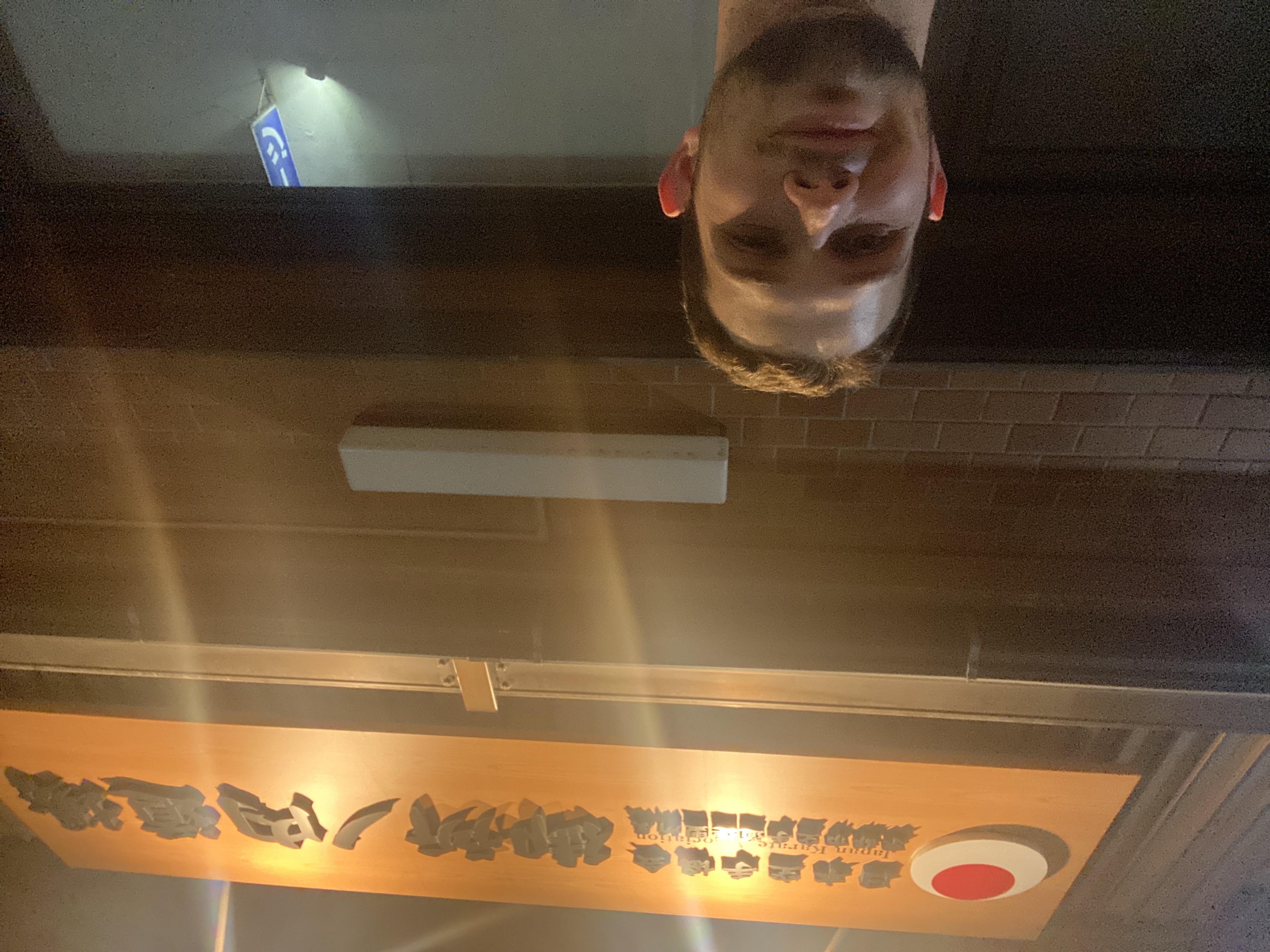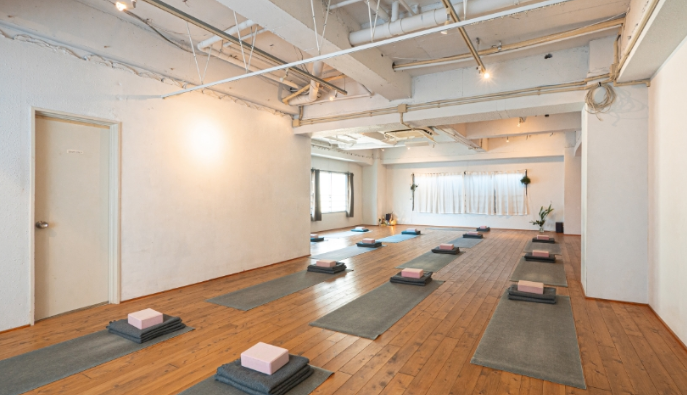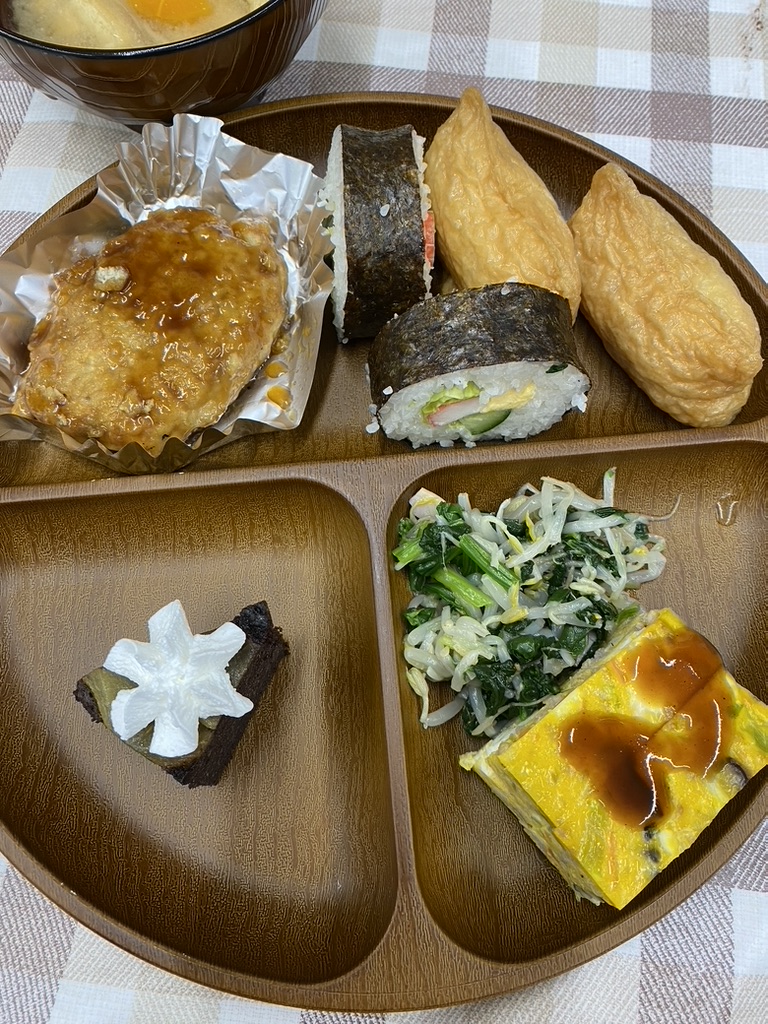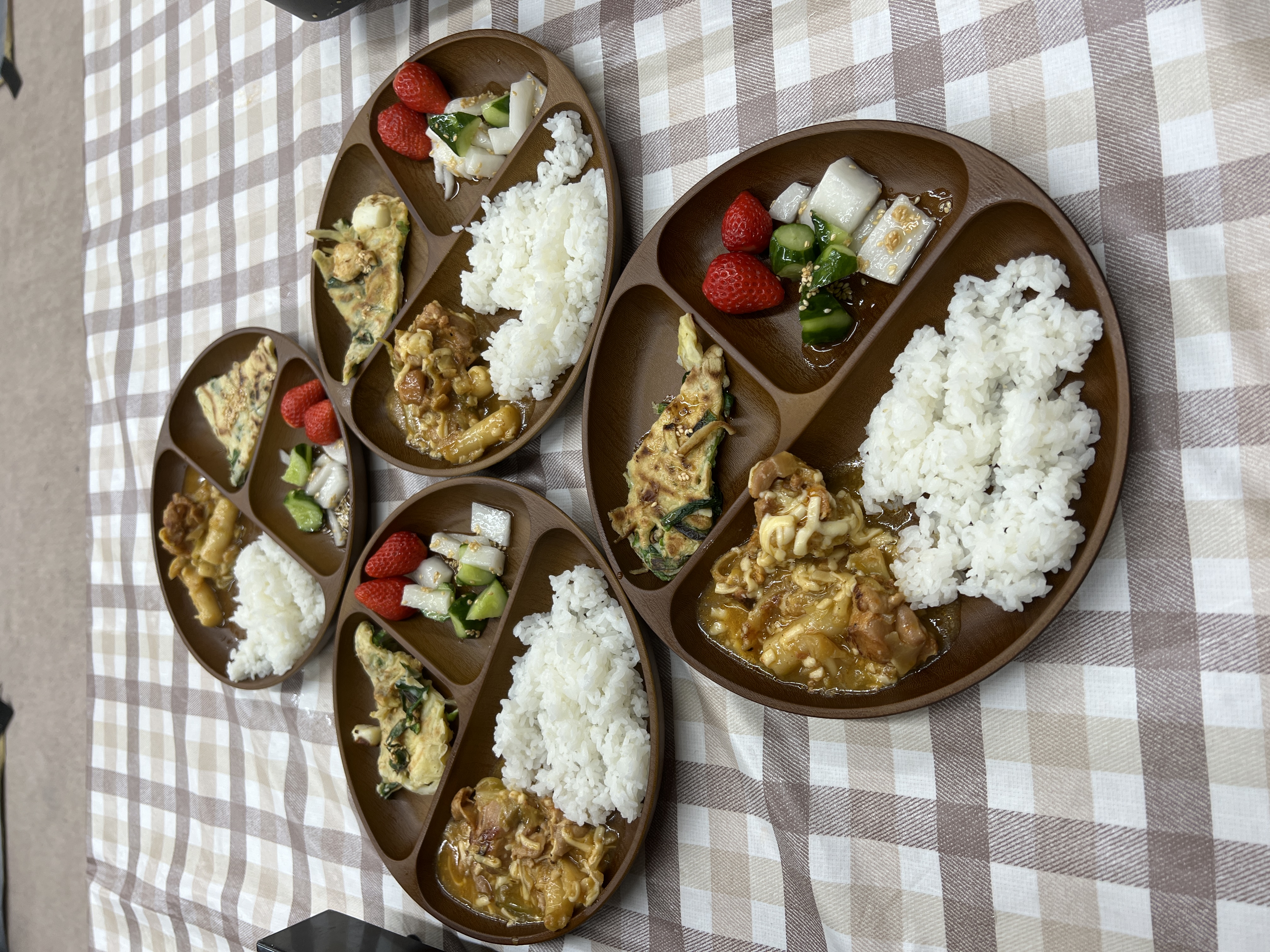 For my CIP, I chose to join a local Shotokan Karate dojo, Goshonouchi dojo, run by Kato Sensei. I joined because I had seen good things in what I found online, and a fellow CIP student was attending and she spoke very well of it. Prior to this I had several years of experience in martial arts, but only in the US, which I can now say, definitely has bit of a culture gap. I found everyone to be very friendly and nice, but they also weren’t afraid to be straightforward when instructing or teaching the formality of karate, something I very much appreciated. If I were to give advice, I would say to ignore any fear or nervousness. One of the strongest points of martial arts is it’s relative simplicity, and in that, a direct way to improve. No one expects perfection and to make a mistake is to learn, so don’t fear making them. Likewise, everyone comes to a dojo for the same reason, so don’t be scared of any of them, even the most serious practitioners are very much friendly if you take the time to talk to them. I actually went out of my way to train with the pro fighter during breaks in between class activities and it’s probably some of the best training I’ve ever gotten. If you don’t let fear hold you back, I promise it’ll be a great time.
For my CIP, I chose to join a local Shotokan Karate dojo, Goshonouchi dojo, run by Kato Sensei. I joined because I had seen good things in what I found online, and a fellow CIP student was attending and she spoke very well of it. Prior to this I had several years of experience in martial arts, but only in the US, which I can now say, definitely has bit of a culture gap. I found everyone to be very friendly and nice, but they also weren’t afraid to be straightforward when instructing or teaching the formality of karate, something I very much appreciated. If I were to give advice, I would say to ignore any fear or nervousness. One of the strongest points of martial arts is it’s relative simplicity, and in that, a direct way to improve. No one expects perfection and to make a mistake is to learn, so don’t fear making them. Likewise, everyone comes to a dojo for the same reason, so don’t be scared of any of them, even the most serious practitioners are very much friendly if you take the time to talk to them. I actually went out of my way to train with the pro fighter during breaks in between class activities and it’s probably some of the best training I’ve ever gotten. If you don’t let fear hold you back, I promise it’ll be a great time.
「Cornell University」カテゴリーアーカイブ
Alexis Jones: Yoga

My CIP activity was doing yoga every Friday or Thursday at Yoga Tamisa studio near Karasuma Oike station. I was instructed by Asako sensei and, usually, in the room in the attached picture (all in Japanese).
I really enjoyed the course because I always felt included and the more I went, the kinder I felt the staff became. It was very relaxing after a long week and I enjoyed having conversations with Asako sensei and other participants after sessions.
If you are someone that wants a CIP that’ll bring you tranquility, I strongly suggest participating in yoga because you won’t feel different from anyone else, participants range all skill levels, and everyone is extremely kind.
Everett Zelson: Volunteering at Happiness Children's Cafeteria

I volunteered at Happiness Children’s Cafeteria this semester. Every Wednesday I would help serve free meals to local children. The nonprofit also runs a cafe and does study sessions for the students on Mondays.
Volunteers would set up, serve food, eat and play with the kids, and clean up. There was essentially no English spoken, so I was able to practice my Japanese, too.
Advice: Try to help as much as possible. I found that they didn’t usually tell me what to do, so I had to be proactive in offering.
Jiarui Yang: Volunteering at Children's Cafeteria (子ども食堂)
 This semester I volunteered at Happiness Children’s Cafeteria. In this cafeteria, every Wednesday dinners are offered for free for kids from low-income families. Every Monday, the cafeteria also serves as a study room for kids to do their homework.
This semester I volunteered at Happiness Children’s Cafeteria. In this cafeteria, every Wednesday dinners are offered for free for kids from low-income families. Every Monday, the cafeteria also serves as a study room for kids to do their homework.
I went there every Wednesday from 5 pm to 8 pm. Volunteers’ duties include serving dinner, washing the dishes, cleaning up, and playing with kids. There were plenty of opportunities to communicate with kids and other volunteers.
Advice to incoming students: the children’s cafeteria had a chill and casual atmosphere. It is great for anyone who enjoys hanging out with kids. Plus, volunteers can also enjoy free meals with the kids.
Amanda Mihovilovic: English with Kindergarteners
Nearly every week beginning in October of the fall semester, I began volunteering at Fukakusa Kindergarten. A small kindergarten nestled in a residential area on the other side of the Kamo River, I remember how nervous I was my first day! However, all the staff were extremely kind and helpful, making sure I knew what I would be doing with the kids. My time with the kids was comprised of lots of English picture books, random vocabulary the kids wanted to know, and lots of free play time!
I was pleasantly surprised by how enthusiastic the kindergarteners were! Every week they entered the room full of excitement, and would come right up to me to ask to play together or just to ask me how to say certain words in English. As excited as they were to learn from me, I approached every visit just as excited to learn from them. Although not in any formal capacity, through the children and staff I learned so much about how schools operate in Japan! From how snack time and free play time works, to just simply how removing your shoes inside the school is a strictly adhered by custom. I was treated with the utmost respect as just a student visitor, and I was blown away by how much of a positive experience my CIP ended up being. More practically, I learned a lot more about Kansai-ben! While this dialect is often heard in Kyoto, across the Kamo River it’s almost all you exclusively hear from the locals. Picking up Kansai-ben in my interactions with the staff and the students really helped me feel more confident in my Japanese as a whole.
My CIP experience is one I’m eternally grateful for, and I’m so glad I got the opportunity to participate in it thanks to the help of the KCJS office. Exploring an area of Kyoto I had previously never seen, interacting with a dialect I was unfamiliar with but wanted to learn, and simply being able to be around the cutest children I’ve ever seen are memories and lessons I will never forget.
Lisa Morton: Intern at Misonou Lab
For my CIP, I was lucky enough to volunteer as a research intern in the Misonou Lab at the Doshisha Graduate School of Brain Sciences. The lab focuses on the cell biology of neurons, specifically the nature of tau proteins and the role they play in the pathology of Alzheimer’s disease. The work being done in Misonou sensei’s lab is fascinating, and it was humbling to get to witness the day-to-day work that (I believe) will amount to life-improving findings. I primarily spent my time assisting two PhD students in the lab, and in them, I feel like I have found not only mentors and role models but true friends. Initially, our relationship was quite professional, but we bonded through the challenges and successes we shared in the lab. At first, I wondered if this bond I felt I shared with them was all in my head. I figured to them, I might be more of a burden than anything — that American intern who doesn’t understand any Japanese scientific terms and gets in the way more than she helps. A few weeks into interning, however, they began inviting me to hang out and explore Kyoto and Osaka on the weekends. Having afternoon tea in Osaka Castle park and admiring a lunar eclipse together with them have got to be some of my most treasured memories from all of KCJS. Misonou sensei once told me that he was excited to have me as an intern because he thought my “American friendliness” might help bring his busy grad students out of their shells. This was immediately hilarious to me as an introverted over-thinker, and I worried that I might let him down somehow. After all, the grad students were undeniably incredibly busy, and at first, were incredibly formal and serious. I now believe this to be less about them having shy personalities or them playing into Japanese social customs and more about the deep respect they have for each other and for the work at hand. This is something I truly admire and will take away with me as I continue my studies in America. Because this respect is something we all mutually shared (and because I may be undermining American stereotypes with my lack of outgoingness), our bond was slow to form but is deep. I am incredibly grateful for this. When I return to America, I hope to stay in touch with everyone in the lab, and even have plans to meet one of the grad students next year at a neuroscience conference!
Christine Ahn : Shamisen Lessons
For my CIP, I chose to learn the Shamisen under Iwasaki sensei. Since previous students from KCJS had already taken lessons from her, it was easy to start (although contacting her was a bit of a struggle since she was always out when we called). On the first day, I was nervous but going with another KCJS student, Alexis, made it less stressful. The first day, we were welcomed in during the middle of a lesson, which felt more like a rehearsal. Like previous posts already made, the lessons aren’t really like lessons and more of practicing together. By playing with the other students, I found myself slowly improving while having fun. The other students were all old, but they were energetic and treated us kindly. They even sent us back home with chocolates on the first day.
I knew that I wanted to push myself to talk more so I would also ask a few questions here and there whether it be about trying to understand the sheet music (which is very different from western sheet music) or asking how long they’ve been playing. It was hard for me to start or continue a conversation but luckily, the other students, and Alexis who came with me, were pretty talkative. During lessons, everyone mainly focuses on playing the piece so there isn’t much opportunity to talk then. It may be different depending on when you set your lesson time since each time we came in, the students there were already rehearsing a piece so there was no chance to talk before a lesson. After each lesson, however, they offered to treat us out to dinner providing an optimal time to chat with them and the teacher. It was interesting to me that even though they were much, much older than us, they told us to call them by their nicknames and gave us nicknames too. They told us some stories about themselves and in exchange, we also gave some of our own. I also saw that even quieter students became so talkative after they started drinking.
Since our program in Japan ended abruptly, I couldn’t properly say bye to them but was able to eat with Iwasaki sensei one last time before leaving. I was able to talk a lot then and before we left, she showed us around an antique cafe she liked (The interior was really cool. I highly recommend asking her about it so you can go too). I really enjoyed how kind the other students and teacher were, even though it was awkward at times. If I could go more times, I think instead of relying on the other students to talk, I would’ve definitely pushed myself to talk even more and try to practice keigo more with the teacher. They understand we’re learning Japanese and have fun hearing us talk so I recommend just saying anything, even if it sounds dumb, off, or random, and to try to treat them as friends (with respect though). Overall, the experience was really enjoyable. However, my goal was to be in a CIP with a lot of people to talk with so this fulfills that but if you want to make friends with younger people, I would suggest finding an active club.
Sophie Matsumoto: Bible Study
When I came to Japan, I wanted to get involved in Japanese life in a way that felt natural for me. I am involved in a Christian organization on the Cornell campus, and I was hoping to get involved in one on the Doshisha campus. I found out about KGK イエス会through a teacher and some friends, and I decided to attend their Monday afternoon Bible study. Since majority of the members are Japanese students, we read and discuss the Bible in Japanese. We have been reading through the book of Revelation each week. As one of the more complicated books in the Bible, it has been difficult to understand in a language that is not my mother tongue. However, I have been able to learn a lot from reading both the English translation and the Japanese translation. It has been a great experience for me in terms of improving my Japanese vocabulary knowledge, learning about Japanese culture, and learning more about the Bible.
When it came to the discussions, I noticed how they differed from ones I was used to in America. In America, I was accustomed to loud discussions where people are quick to speak their opinion. While it is important to express one’s opinion, I really appreciated how all of the Japanese students would take the time to try to understand everyone’s opinions before expressing their own. It is a style of discussion that I would like to take home to America with me because it makes people unafraid to share their feelings and opinions.
After living in Japan for a while, I have come to realize how Christian community looks different in Japan compared to what it looks like in America. Since Japan has such a small population of Christians, I found it to be a little more difficult to find a Christian community here. America has many places for people to find community, so people sometimes switch from group to group or place to place. In Japan, however, there are not too many places to find the community they want, but since it is difficult to find, people treasure it when they do find it. They create a small support system for the people in their community and act as an open space for anyone to join. Since everyone knows each other for the most part, they are able to get to know each other better and offer support easily. I really appreciated feeling a part of their community immediately by getting to have conversations with each person individually. The students in the Bible study have all been extremely welcoming to everyone.
It has been interesting to learn about what Christianity in Japan and America looks like from the other students’ perspectives. We have been able to discuss differences in culture and the way Christianity can be framed within them. For example, although people in Japan and America identify as Christian, values differ from person to person in both countries. Another example is the culture surrounding religion and the perception of American mega churches from Japanese people. Although many of our discussions revolved around serious topics, we have had a lot of fun just getting together and reading the Bible. Besides weekly Bible studies, they hold occasional events, such as takoyaki parties, where everyone just spends time together to get to know one another. Being a part of this group has obviously been a great way for me to learn more about Japan and the Bible, but it has also been a great way for me to make friends. It has allowed me to get more involved on the Doshisha campus and feel more at home in Japan.
Benjamin Hofing: Ultimate Frisbee
For my CIP, I joined various Ultimate Frisbee teams around Kyoto. Since I have been playing Ultimate for years already, this seemed like a good choice for me. I thought it would be much easier to communicate since I already knew plenty of things about the sport. I could not have been more wrong. While it definitely helped that I already knew the jist of what was going on, I sometimes had a tough time understanding what was going on.
Fortunately, everyone was very accommodating. When I couldn’t understand some of what was going on, someone would sit with me and draw the situation out, explaining the necessary vocabulary as we went. In addition, there were a few people who spoke English, who occasionally helped me out when I was struggling really badly.
At first, when I found out there were several people who could speak English, I was nervous that I would become reliant on them: it would be far easier to speak with them in English, and then have them help translate into Japanese, than it would be for me to learn the myriad of vocabulary that would be necessary to explain myself. If this had happened, I don’t think I would have gotten much out of this experience. But it didn’t. Instead, I forced myself to speak Japanese, even when I was talking with the people who could speak English. At first, it was very difficult, but I slowly acclimated. Since I sometimes had practice on both Saturdays and Sundays, it got to a point where I would go whole weekends without speaking English. Thanks to this, I got lots of speaking practice, while having fun at the same time.
Angel Yi Fei Ding : Shamisen
My first time encountering the shamisen was at a taiko performance by a student group named Yamatai on Cornell’s campus. I remember sitting in the massive concert hall and awing at the explosive, yet pure beats accompanied by two Japanese pluck instruments. During the performance, one string on one instrument snapped, but the performer remained calm and continued the notes with the remaining strings.
As music has been a part of my life in many different ways and forms over the past 15 years, I decided to keep it in my life even during my times abroad. Learning a traditional Japanese instrument became a natural option and drawing from my memory regarding that taiko performance I saw over a year ago, that accompanying instrument came to mind. I decided to learn the shamisen. With the recommendations of KCJS teachers, I, along with another KCJS student who wanted to learn the koto, contacted Iwasaki Sensei. My CIP became one of the best highlights of my time in Kyoto.
It is fair to say that Chloe and I walked into the unknown. With the help of our teacher, we called Iwasaki sensei in somewhat broken Japanese and arranged to meet that exact afternoon. I thought we were simply meeting to introduce ourselves, but we jumped into practice, and Tuesdays became our lesson time. In the first two weeks or so, Iwasaki sensei taught me shamisen basics like reading traditional Japanese music notation and learning the basic positions. Coming from over 15 years of violin practice, I was able to catch the basic, basic, fundamentals, and we moved onto pieces.
Iwasaki sensei’s classroom is conducted in a fairly unique style with students of all sorts of backgrounds. Our usual Tuesday group ranges from a 6-year-old pre-elementary girl to 60-year-old grandmas, and we always have so much fun. Since I don’t have other activities planned on Tuesdays, I tend to spend around 3 hours at the studio. We play different pieces, varying in difficulty, and I often have flashbacks of my time back in orchestra when we have multiple shakuhachis 「尺八」( bamboo flute), kotos 「琴」(Japanese harp), and shamisens 「三味線」play all together.
This classroom was also the perfect place to observe Kansai’s hospitality and customs. The students spoke with kansaiben「関西弁」 and used kansai-keigo「関西敬語」 ( which is the best invention) and interacted with each other in a fun way. Sometimes different students would bring omiyage「お土産」 or ogashi「お菓子」, and we would teatime in between the lesson and chat freely.
It has been an amazing time, and I really look forward to our Christmas performance on December 14th. I will cherish the few weeks we have left with the small studio and make the best out of it.
